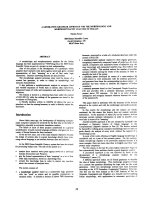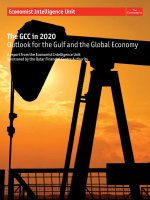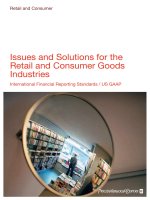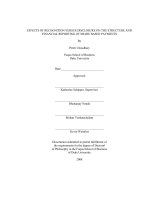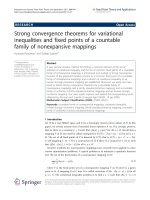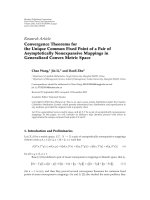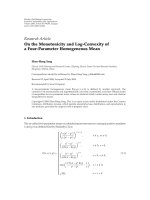Asymmetric cost behavior implications for the credit and financial risk of a firm
Bạn đang xem bản rút gọn của tài liệu. Xem và tải ngay bản đầy đủ của tài liệu tại đây (2.82 MB, 174 trang )
Quantitatives Controlling
Carsten Homburg Hrsg.
Kristina Reimer
Asymmetric
Cost Behavior
Implications for the Credit
and Financial Risk of a Firm
Quantitatives Controlling
Series editor
C. Homburg, Köln, Germany
The series serves as a panel for outstanding research in the field of accounting. The
underlying concept of accounting goes beyond the scope of traditional corporate
accounting including, for instance, aspects of behavior control. The series focuses on
quantitative analyses of current topics in management and financial accounting
and considers both analytical and empirical research designs.
Edited by
Univ.-Prof. Dr. Carsten Homburg
Universität zu Köln
More information about this series at />
Kristina Reimer
Asymmetric Cost Behavior
Implications for the Credit
and Financial Risk of a Firm
With a foreword by Univ.-Prof. Dr. Carsten Homburg
Kristina Reimer
Köln, Germany
Dissertation Universität zu Köln 2017
Quantitatives Controlling
ISBN 978-3-658-22821-7
ISBN 978-3-658-22822-4 (eBook)
/>Library of Congress Control Number: 2018948631
Springer Gabler
© Springer Fachmedien Wiesbaden GmbH, part of Springer Nature 2019
This work is subject to copyright. All rights are reserved by the Publisher, whether the whole or part
of the material is concerned, specifically the rights of translation, reprinting, reuse of illustrations,
recitation, broadcasting, reproduction on microfilms or in any other physical way, and transmission
or information storage and retrieval, electronic adaptation, computer software, or by similar or
dissimilar methodology now known or hereafter developed.
The use of general descriptive names, registered names, trademarks, service marks, etc. in this
publication does not imply, even in the absence of a specific statement, that such names are exempt
from the relevant protective laws and regulations and therefore free for general use.
The publisher, the authors and the editors are safe to assume that the advice and information in this
book are believed to be true and accurate at the date of publication. Neither the publisher nor the
authors or the editors give a warranty, express or implied, with respect to the material contained
herein or for any errors or omissions that may have been made. The publisher remains neutral with
regard to jurisdictional claims in published maps and institutional affiliations.
Printed on acid-free paper
This Springer Gabler imprint is published by the registered company Springer Fachmedien Wiesbaden
GmbH part of Springer Nature
The registered company address is: Abraham-Lincoln-Str. 46, 65189 Wiesbaden, Germany
Geleitwort
Die vorliegende Dissertation beschäftigt sich mit dem Phänomen des
asymmetrischen Kostenverhaltens (Kostenremanenz) und den Auswirkungen dieses
Phänomens auf das Kredit- und Finanzrisiko eines Unternehmens. Die Arbeit ist in
sechs Kapitel unterteilt. Nach der Einführung werden die theoretischen Grundlagen
der Kostenremanenz sowie die Grundlagen des Kreditrisikos dargestellt. Die Arbeit
beinhaltet weiterhin zwei empirische Studien, welche die Effekte der Kostenremanenz auf das Kredit- und Finanzrisiko untersuchen. In der Schlussbetrachtung
werden die Einschränkungen der Dissertation diskutiert sowie Vorschläge für
weitere Überlegungen herausgearbeitet.
Kapitel 1 befasst sich mit dem Konzept der Kostenremanenz. Beginnend mit den
ersten Erwähnungen in den zwanziger Jahren des letzten Jahrhunderts wird die
Literatur aufgearbeitet und die Ergebnisse des Forschungsstands präsentiert. Im
nächsten Schritt werden die theoretischen Grundlagen analysiert. Zu diesem Zweck
werden Ursprung, Entstehungsursachen und empirische Modelle erarbeitet, sowie
das Konzept der Kostenremanenz kritisch betrachtet. Dabei werden die Ursachen
umfassend und gründlich systematisch dargestellt und diskutiert.
Die Kategorisierung der Ursachen ist in diesem Umfang und Detailreichtum neu in
der Forschungsliteratur. Insbesondere werden die Entstehungsursachen in
Abhängigkeit von der Intention des Managements analysiert.
Weiterhin werden innerhalb der theoretischen Grundlagen der Arbeit die
empirischen Modelle zur Messung der Kostenremanenz analysiert, verglichen und
die Vor- und Nachteile diskutiert. Im zweiten Teil vom Kapitel 2 wird ein
Literaturüberblick zum Thema asymmetrisches Kostenverhalten gegeben. Dabei
werden die empirischen Studien gemäß ihrer primären Hauptziele kategorisiert:
Nachweis der Existenz, Untersuchung der Determinanten sowie Implikationen der
Kostenremanenz. Das Kapitel schließt mit einer kritischen Würdigung der
Kostenasymmetrie.
In Antizipation der darauffolgenden empirischen Studie stellt das dritte Kapitel die
theoretischen Grundlagen zum Thema Kreditrisiko dar. Nach der Definition und
Klassifikation des Begriffs folgen Analyse und Vergleich der Modelle zur Messung
des Kreditrisikos eines Unternehmens. Dabei wird neben den etablierten
theoretischen Modellen wie Struktur- und Intensitätsmodelle das Kreditderivat
VI
Geleitwort
Credit Default Swap (CDS) zur Messung des Kreditrisikos anhand der Ergebnisse
der aktuellen empirischen Studien untersucht und diskutiert.
Das vierte Kapitel umfasst eine empirische Studie, welche die Auswirkungen von
Kostenremanenz auf das Kreditrisiko eines Unternehmens untersucht. Bei einem
Umsatzrückgang werden Ressourcen freigesetzt. Unabhängig von der Quelle der
Kostenremanenz, d.h. unabhängig davon, ob die Kostenremanenz das Resultat einer
rationalen Handlung des Managements, eines Agency Problems oder als
Konsequenz der in der Vergangenheit getroffenen Entscheidungen ist, wird die
Kostenremanenz als Investition in ein riskantes Projekt angesehen, dessen Rendite
von der unsicheren zukünftigen Nachfrage abhängt. Damit erhöht sich das
Kreditrisiko, dass die Unternehmen ihren zukünftigen Zahlungsverpflichtungen
nicht nachkommen können. Aufgrund der Ergebnisse der aktuellen Forschungsliteratur im relevanten Themengebiet werden insgesamt drei Wege ausgearbeitet,
wie Kostenremanenz das Kreditrisiko beeinflusst.
Die durchgeführte Studie bereichert die Rechnungslegungs- sowie die
Finanzliteratur. In Bezug auf die Rechnungslegungsliteratur wird eine neue
Implikation der Kostenremanenz identifiziert und analysiert. Die Finanzliteratur
wird durch die Dokumentation einer neuen Determinante in der Preisgestaltung der
CDS Prämien bereichert. Das Ergebnis der negativen Kreditmarktreaktion auf das
asymmetrische Kostenverhalten ist ebenfalls von praktischer Bedeutung. Manager
können von der Erkenntnis profitieren, dass der Verzicht auf Ressourcenanpassungen bei einem Umsatzrückgang zum erhöhten Kreditrisiko und damit zu
höheren Finanzierungskosten führt. Eine weitere praktische Konsequenz ist, dass
die Erkenntnisse der Studie Gläubigern, Analysten und Ratingagenturen helfen
können, das Kreditrisiko in Bezug auf asymmetrische Kostenentscheidungen
genauer zu prognostizieren.
Das fünfte Kapitel umfasst eine weitere empirische Studie, welche den Einfluss des
asymmetrischen Kostenverhaltens auf das finanzielle Risiko eines Unternehmens
untersucht. Während in der ersten empirischen Studie der Fokus auf den
Implikationen für die Fremdkapitalgeber liegt, analysiert die zweite Studie
Auswirkungen der Kostenremanenz im Hinblick auf die Eigenkapitalgeber. Es wird
eine Hypothese hergeleitet ausgehend vom Risiko über das Niveau und die Stabilität
des operativen Cashflows eines Unternehmens mit ausgeprägter Kostenremanenz.
Es wird argumentiert, dass die Eigentümer eine Kompensation für das zusätzliche
Risiko verlangen, welches sich in erhöhten Prämien widerspiegelt.
In der Schlussbetrachtung der Dissertation werden die Einschränkungen der Studien
besprochen sowie Vorschläge für weitere Forschung aufgeführt. Diese umfassen die
Untersuchung des optimalen Grads an Kostenremanenz, die Unterscheidung
Geleitwort
VII
zwischen der „guten“ (wertsteigender) und “schlechten“ (wertsenkender)
Kostenremanenz, die Analyse der nicht intendierten und unvermeidbaren
Kostenremanenz und schließlich das asymmetrische Kostenverhalten in Non-ProfitOrganisationen.
Insgesamt ist der Autorin eine hervorragende Arbeit gelungen, die sich durch einen
hohen Innovationsgrad auszeichnet.
Univ.-Prof. Dr. C. Homburg
Vorwort
Die vorliegende Arbeit entstand während meiner Tätigkeit als wissenschaftliche
Mitarbeiterin am Seminar für Allgemeine Betriebswirtschaftslehre und Controlling
der Universität zu Köln. Nach erfolgreichem Abschluss meiner Promotion möchte
ich die folgenden Zeilen dazu nutzen, den Personen zu danken, die zum
erfolgreichen Abschluss meines Dissertationsprojektes beigetragen haben.
Zuallererst möchte ich mich herzlich bei meinem Doktorvater und akademischen
Lehrer, Herrn Prof. Dr. Carsten Homburg für die vielfältige Unterstützung sowie die
Gewährung des zeitlichen und geistigen Freiraums bei der Erstellung dieser Arbeit
bedanken. Unseren persönlichen und fachlichen Austausch habe ich sehr geschätzt.
Mein weiterer Dank gilt Frau Prof. Uhrig-Homburg und Frau Jun.-Prof. Julia Nasev
für die anregenden und sehr lehrreichen Diskussionen. Weiterhin danke ich dem
Förderverein Controlling, dessen finanzielle Unterstützung die Teilnahme an
internationalen wissenschaftlichen Konferenzen sowie die Beschaffung der für die
Forschung notwendigen empirischen Daten ermöglicht hat. Ebenso möchte ich
Herrn Prof. Dr. Thomas Hartmann-Wendels für die Übernahme des Zweitgutachtens und Herrn Prof. Dr. Ludwig Kuntz für den Vorsitz bei meiner
Disputation danken.
Meinen Lehrstuhlkollegen Dr. Daniel Baumgarten, Dr. Max Berens, Dr. Snjezana
Deno, Dr. Sebastian Gell, André Hoppe, Dr. Tanja Lorenz, Dr. Christian MüllerHammerstein, Sabine Nentwig, Jun.-Prof. Julia Nasev, Dr. Dominik Nußman, Dr.
Philipp Plank, Lars Rothe, Roman Schick, Dr. Simon Zehnder danke ich für die sehr
gute Zusammenarbeit, die interessanten Diskussionen und die schöne gemeinsame
Zeit. Ein besonderer Dank gilt meiner lieben Kollegin Dr. Stefanie Liesenfeld, die
mir durch viele anregende Gespräche zu einer wertvollen und freundschaftlichen
Wegbegleiterin wurde. Weiterer Dank gilt den studentischen Hilfskräften des
Lehrstuhls, die mit ihrem Engagement wertvolle Hilfestellungen in Forschung und
Lehre gaben. Weiterhin danke ich den ehemaligen Mitarbeitern des Seminars,
insbesondere Prof. Dr. Sönke Sievers und Dr. Ute Bonenkamp für die einzigartige
Hilfsbereitschaft und stets guten Rat. Nicht zuletzt möchte ich mich bei Elisabeth
Tokarski-Eich und Tanja Breuer für die vielseitige Unterstützung bedanken. Ihre
Erfahrung und Hilfsbereitschaft haben maßgeblich zu dem herzlichen und
harmonischen Arbeitsklima am Lehrstuhl beigetragen.
X
Vorwort
Im privaten Bereich danke ich meinen Freundeskreis, der immer an mich geglaubt
und unterstützt hat. Besonderer Dank gilt meinen Eltern Ludmilla und Waldemar
Romaker, meiner Schwester Lena und meinen viel zu früh verstorbenen Großeltern.
Mit ihrer bedingungslosen Unterstützung haben sie mir einen großen Rückhalt
während meines Studiums und meiner Dissertation geboten.
Der allergrößte Dank gebührt meinem Ehemann Andreas und meiner Tochter
Sophia. Eure Liebe, Geduld und Verständnis haben diese Arbeit möglich gemacht.
In Liebe und Dankbarkeit ist dieses Buch Euch gewidmet.
Kristina Reimer
Table of Contents
List of Figures ..................................................................................................XV
List of Tables .................................................................................................XVII
List of Abbreviations ..................................................................................... XIX
List of Symbols ............................................................................................... XXI
1 Introduction .................................................................................................... 1
2 Cost Stickiness Concept ................................................................................. 5
2.1 The Origin of Cost Stickiness in the Research Literature ........................ 7
2.2 Theoretical Considerations of Cost Stickiness Occurrence ...................... 9
2.2.1 Sources for Intended Cost Stickiness ............................................. 9
2.2.1.1 Rational Managerial Decisions ....................................... 10
2.2.1.2 Irrational Managerial Decisions ...................................... 13
2.2.2 Sources for Unintended Cost Stickiness ....................................... 15
2.3 Empirical Models of Asymmetric Cost Behavior .................................. 17
2.3.1 The Model of Anderson, Banker, and Janakiraman (2003).......... 17
2.3.2 The Model of Weiss (2010).......................................................... 20
2.4 Empirical Research in Asymmetric Cost Behavior ................................ 21
2.4.1 Empirical Evidence on the Existence of Cost Stickiness ............. 21
2.4.1.1 Asymmetric Cost Behavior of Different Cost
Categories ....................................................................... 22
2.4.1.2 Asymmetric Cost Behavior at Different Levels .............. 24
2.4.2 Empirical Evidence of the Cost Stickiness’ Determinants ........... 28
2.4.3 Empirical Evidence of the Cost Stickiness’ Implications ............. 30
2.5 Criticism ................................................................................................. 34
3 Theoretical Foundations of Credit Risk Fundamentals and
Methods of Determining Credit Risk ......................................................... 39
3.1 Definition and Classification of Credit Risk .......................................... 39
3.2 Credit Risk Measurement based on Theoretical Models ........................ 41
3.2.1 Structural Models ......................................................................... 42
XII
Table of Contents
3.2.2 Reduced-Form Models ................................................................. 47
3.3 Credit Risk Measurement based on Credit Default Swaps ..................... 50
3.3.1 Definition and Structure of Credit Default Swap ......................... 50
3.3.2 Credit Default Swap Market......................................................... 51
3.3.3 Credit Default Swaps and Credit Risk.......................................... 57
3.3.4 Discussion of Credit Default Swaps’ Applicability in
Measuring Credit Risk ................................................................. 59
4 Does Cost Stickiness Affect Credit Risk? ................................................... 63
4.1 Idea and Motivation................................................................................ 64
4.2 Related Literature and Hypothesis Development ................................... 66
4.3 Data and Methodology ........................................................................... 69
4.3.1 Sample Selection .......................................................................... 69
4.3.2 Model Specification and Variable Measurement ......................... 72
4.4 Empirical Results ................................................................................... 76
4.4.1 Descriptive Statistics .................................................................... 76
4.4.2 Main Results................................................................................. 80
4.4.3 Cross-Sectional Variation............................................................. 85
4.5 Addressing Endogeneity Concerns ......................................................... 88
4.6 Robustness Checks ................................................................................. 91
4.7 Summary and Conclusion .................................................................... 106
5 Does Cost Stickiness Affect Financial Risk? ............................................ 107
5.1 Introduction and Motivation ................................................................. 107
5.2 Data and Methodology ......................................................................... 109
5.2.1 Sample Selection ........................................................................ 109
5.2.2 Methodology .............................................................................. 110
5.3 Empirical Results ................................................................................. 112
5.3.1 Descriptive Statistics .................................................................. 112
5.3.2 Regression Results ..................................................................... 113
5.3.3 Extended model .......................................................................... 116
5.3.4 Addressing Endogeneity Concerns............................................. 121
5.4 Sensitivity Tests ................................................................................... 122
5.4.1 More Extensive Data Trimming ................................................. 122
5.4.2 Industry Affiliation ..................................................................... 123
5.5 Summary and Conclusion .................................................................... 126
6 Concluding Remarks, Limitations, and Future Research ...................... 129
6.1 Summary of Results ............................................................................. 129
6.2 Limitations and Propositions for Future Research ............................... 130
Table of Contents
XIII
Appendix.......................................................................................................... 133
References........................................................................................................ 141
List of Figures
Figure 1.1:
Figure 2.1:
Figure 2.2:
Figure 2.3:
Figure 2.4:
Figure 2.5:
Figure 2.6:
Figure 3.1:
Figure 3.2:
Figure 3.3:
Figure 3.4:
Figure 3.5:
Figure 3.6:
Figure 3.7:
Figure 3.8:
Figure 4.1:
Figure 4.2:
Figure 5.1:
Figure 5.2:
Structure of the Thesis ..................................................................... 4
Structure of Chapter 2 ..................................................................... 6
Cost Stickiness Sources ................................................................... 9
The Dimensions of Rational Managerial Decisions ...................... 11
The Dimensions of Irrational Managerial Decisions ..................... 13
Dimensions of Unintended Cost Stickiness ................................... 15
Dimensions of Cost Stickiness ...................................................... 17
Structure of Chapter 3 ................................................................... 39
Categories of Bank’s Financial Risk ............................................. 41
The Intuition behind the Merton Model ........................................ 43
Payment Structure of a Credit Default Swap ................................. 51
CDS Notionals Outstanding ($bn) ................................................. 52
CDS Market Values ($bn) ............................................................. 54
Relative CDS Market Size............................................................. 55
Credit Derivatives Notionals Outstanding ($bn) ........................... 56
Structure of Chapter 4 ................................................................... 63
Distribution of CDS spreads before and after taking the
logarithm ....................................................................................... 77
Structure of Chapter 5 ................................................................. 107
Relationships between Market Risk, Business Risk, Default
Risk, and Financial Risk .............................................................. 108
List of Tables
Table 2.1:
Table 2.2:
Table 2.3:
Table 4.1:
Table 4.2:
Table 4.3:
Table 4.4:
Table 4.5:
Stickiness of different cost components ........................................ 22
Country-specific prevalence of cost stickiness .............................. 25
Determinants of cost stickiness ..................................................... 28
Frequency of observations of the main sample ............................. 71
Descriptive statistics of the main sample ...................................... 78
Regression results based on the main sample ................................ 81
The effect of favorable conditions ................................................. 87
Regression results lagging the main independent variable
STICKY for the sample covering 5-year CDS contracts and all
maturities ....................................................................................... 89
Table 4.6: Regression results based on the extended sample ......................... 92
Table 4.7: Robustness based on firm random effects for the sample
covering 5-year CDS contracts ...................................................... 95
Table 4.8: Robustness based on industry fixed effects for the sample
covering 5-year CDS contracts ...................................................... 97
Table 4.9: Robustness based on quarter & firm fixed effects and quarter
& industry fixed effects for the sample covering 5-year CDS
contracts ........................................................................................ 98
Table 4.10: Robustness based on seniority/subordination for the sample
covering 5-year CDS contracts .................................................... 100
Table 4.11: Robustness based on a dummy variable for cost stickiness for
the sample covering 5-year CDS contracts .................................. 103
Table 4.12: Robustness based on alternative outlier treatment for the
sample covering 5-year CDS contracts ....................................... 104
Table 5.1: Descriptive statistics of the main variables ................................. 112
Table 5.2: Cost stickiness and the expected cost of equity ........................... 113
Table 5.3: Standardized impact of cost stickiness on the expected cost of
equity ........................................................................................... 115
Table 5.4: Impact of cost stickiness on the expected cost of equity
controlling for leverage and profitability ..................................... 118
Table 5.5: Standardized impact of cost stickiness on the expected cost of
equity in the extended model ....................................................... 120
Table 5.6: Regression results lagging the main independent variable
STICKY ...................................................................................... 121
Table 5.7: Robustness analysis ..................................................................... 123
XVIII
Table A.1:
Table A.2:
List of Tables
Standardized impact of cost stickiness on credit risk .................. 136
Impact of cost stickiness on credit risk measured with CDS
premia in basis points .................................................................. 138
List of Abbreviations
ABJ
BIS
bn
CDS
CEO
COGS
CRSP
e.g.
Eq. (Eqs.)
et al.
etc.
EURO STOXX 50
exp.
FE
GDP
i.e.
ISDA
MM
MV
OLS
OTC
p.
p.a.
pp.
R&D
RE
RTW
S&P 500
s.d.
SEC
SG&A
SIC
UK
US
Anderson, Banker, and Janakiraman
Bank for International Settlements
billion
Credit Default Swap
Chief Executive Officer
Costs of Goods Sold
Center for Research in Security Prices
exempli gratia (for example)
Equation (Equations)
et alii (and others)
et cetera
Stock index of Eurozone stocks
expected
Fixed Effects
Gross Domestic Product
id est (that is)
International Swaps and Derivatives Association
Mille Mille (thousand thousands)
Market Value
Ordinary Least Squares
Over-The-Counter
page
per annum
pages
Research and Development
Random Effects
Right-to-Work
Standard & Poor’s 500
standard deviation
Securities and Exchange Commission
Selling, General and Administrative
Standard Industrial Classification
United Kingdom
United States
XX
USA
Vol.
List of Abbreviations
United States of America
Volume
List of Symbols
Latin Symbols
B
B*
B0
BETA_Ri,t
BETAi,t
BM_Ri,t
BMi,t
c
COEi,t
CONDi,t
Controli,t
Costi,t (t-1)
cs
CUMRi,t
D
D_k
D_STICKYi,t
value of the default-risk-free bond
market value of a risky debt
price of defaultable bond matured in T
proxy for CAPM beta of firm i at year t not
explained by cost stickiness
CAPM beta of firm i at time t
proxy for book-to-market ratio of firm i at year t not
explained by cost stickiness
book-to-market ratio of firm i at year t
coupon payment
expected cost of capital of firm i for year t
proxy for favourable conditions of firm i at time t
one of the control variables of firm i at year t
costs of firm i in period end of t, t-1 respectively
credit spread
indicator variable equal to 1 if the CDS contract of
firm i at time t has a full restructuring clause and 0
otherwise
face value of firm’s debt
indicator variable denoting CDS maturities of k
years
dummy variable equal to 1 if a firm i exhibits sticky
cost behavior in period end of t and 0 otherwise
Decrease_Dummyi,t-1
indicator variable equal to 1 when activity level
decreases from the period t-1 to t, and 0 otherwise
EARNINGS i,t (t-1)
income before extraordinary items of firm i in period
end of t, t-1 respectively
EXRi,t
indicator variable equal to 1 if the CDS contract of
firm i at time t has no restructuring clause and 0
otherwise
XXII
HMLm
̅̅̅̅̅̅̅
𝐻𝑀𝐿
i
L
L_STICKYi,t
LEV_Ri,t
LEV_UAi,t
LEVi,t
log(…)
LOG_CDSi,t(t+1)
LOGSIZE_Ri,t
LOGSIZEi,t
m
MVi,t
N
N(.)
P
q
r*
R2
REPUBLICANi,t
List of Symbols
value benchmark factor during month m
expected annual excess return on value portfolio
index for a stock or firm
leverage ratio
lag operator applied on STICKYi,t+1
proxy for leverage of firm i at year t not explained
by cost stickiness
unadjusted leverage of firm i in period end of t
computed as long term debt scaled by the value of
assets
leverage of firm i in period end of t not explained by
cost stickiness
logarithm of (…)
natural logarithm of CDS spreads of firm i at quarter
t, t+1 respectively
proxy for size of firm i at year t not explained by
cost stickiness
natural logarithm of the market value of firm i at
year t
end of month m
market value of equity of firm i at time t
number of observations
standardized cumulative density function
value of the put option
survival probability
yield to maturity
coefficient of determination of regression
indicator variable equal to 1, if firm i is
headquartered in a state under influence of
Republican Party at time t and 0 otherwise
rf
̅̅̅
𝑟𝑓
𝑟𝑇𝑑
𝑓
𝑟𝑇
RFt
RMRFm
̅̅̅̅̅̅̅̅
𝑅𝑀𝑅𝐹
risk-free interest rate
expected annual risk-free rate
yield to maturity of a defaultable bond
yield to maturity of a default-risk-free bond
risk-free rate at time t
market benchmark factor during month m
expected annual excess return on market portfolio
ROA_Ri,t
proxy for profitability of firm i at year t not
List of Symbols
XXIII
explained by cost stickiness
ROA_UAi,t
unadjusted return on assets of a firm i at time t
calculated as quarterly income before extraordinary
items scaled by total assets in the previous period
ROAi,t
return on assets of a firm i at time t not explained by
cost stickiness
indicator variable equal to 1 if a firm i is
headquartered in a state that passed right-to-work
law up to time t
RTWi,t
SENIORITYi,t
indicator variable equal to 1 if the underlying CDS
contract of firm i at time t is senior and 0 otherwise
SG&Ai,t (t-1)
Selling, general and administrative costs of firm i in
period end of t, t-1 respectively
SIZE_UAi,t
unadjusted firm size of firm i in period end of t
computed as logarithm of market value
SIZEi,t
size of firm i in period end of t not explained by cost
stickiness
SMB
̅̅̅̅̅̅
𝑆𝑀𝐵
SPREADi,t
size benchmark factor during month m
expected annual return on size portfolio
CDS spread in basis points of CDS contract of firm i
at time t
measure for the stickiness of a firm i at time t
period t, proxy for different time variables
maturity date of a debt
standard deviation of daily returns of firm i during
the firm’s current fiscal quarter
STICKYi,t
t
T
VOL_UAi,t
VOLi,t
proxy for asset volatility of firm i of firm i not
explained by cost stickiness
Vt
VT
asset value of a firm at time t
asset value of a firm at time T
XXIV
List of Symbols
Greek Symbols
ˆ
l
regression coefficient or intercept
regression coefficient or intercept
estimated value of regression coefficient or intercept
𝜎
loading on factor l
coefficient indicating the first derivative
change in costs
change in sales
error term, residual of a regression
recovery rate
most recent of the last four quarters (years) with an
increase in sales
most recent of the last four quarters (years) with a
decrease in sales
standard deviation of returns on the asset value
Further Symbols
$
*** (**, *)
ATQ
CEQ
CSHOQ
DLTTQ
IBQ
LTQ
PRCCQ
RET
SALEQ
Dollar
significance at the 1 %- (5 %-, 10 %) level
total assets at quarter end
common equity
common shares outstanding
long term debt at quarter end
quarterly income before extraordinary items
total liabilities at quarter end
close price at quarter end
daily return
sales at quarter end
𝛿
∆COST
∆SALE
𝜏
𝜏
1
Introduction
Understanding cost behavior is crucial for various participants of capital markets.
Managers for example are engaged to manage costs efficiently since costs determine
earnings, which in turn are often used to evaluate firms’ and managers’
performance. More specifically, in competitive markets where the prices are
predetermined, managers can increase profitability by focusing on costs. Analysts,
creditors, and investors for example make significant efforts to analyze and predict
cost behavior since it is highly relevant in line with predicting sales in order to
estimate future earnings more precisely. Further, corporate outsiders evaluate firms’
performance inter alia on management’s ability to efficiently control costs.
The traditional view of cost behavior distinguishes between fixed and variable costs
with regard to changes in the activity level of a firm. Fixed costs are considered to
be independent of the activity level, 1 where variable costs are assumed to be
proportional with respect to the changes in the activity level (Noreen 1991).
However, contrary to this traditional view of linear and proportional cost behavior,
various studies find empirical evidence for asymmetric cost behavior. This new era
of asymmetric cost behavior in the accounting literature was initiated by Anderson,
Banker, and Janakiraman (2003) who documented that the relation of cost and
volume depends on direction of activity changes and that costs decrease less when
activity level decreases than they increase for an equivalent activity increase. Costs
exhibiting the described asymmetric behavior are labeled as “sticky” and the
phenomenon of asymmetric cost behavior as “cost stickiness”. A large number of
subsequent studies have examined the sources, determinants, and consequences of
the asymmetric cost behavior. The main objective of my doctoral thesis is thus to
deliver a comprehensive literature overview of the existing theoretical and empirical
findings in this area and to provide empirical evidence of two new implications of
asymmetric cost behavior.
For this purpose I first present the cost stickiness concept as a whole in Chapter 2.
Thereby I analyze and structure the most important findings in the asymmetric cost
behavior literature. I start with the origin of asymmetric cost behavior in the
research literature and continue with a theoretical discussion of various sources for
the cost stickiness occurrence. In the second part of Chapter 2 I provide a
1
More precisely, fixed costs are independent from the changes in activity level only in the short run
since in the long run all costs are variable (see Cooper and Kaplan 1988, p. 27).
© Springer Fachmedien Wiesbaden GmbH, part of Springer Nature 2019
K. Reimer, Asymmetric Cost Behavior, Quantitatives Controlling,
/>
2
1 Introduction
comprehensive literature review of the most important empirical research papers on
asymmetric costs in the accounting research and assign them to models, empirical
evidence on the existence of cost stickiness, its determinants, and implications. I
further discuss the contrarian claims against asymmetric cost behavior and review
research studies that criticize the cost stickiness concept. Thus, Chapter 2 builds a
theoretical fundament for my doctoral thesis and offers a comprehensive and
structured review of the cost stickiness literature.
Chapter 3 provides a basic framework of credit risk fundamentals required for the
empirical study in Chapter 4. I first review the main theoretical models, structural
and reduced-form models for pricing credit risk. A considerable part of this chapter
is dedicated to the most popular credit derivative, namely the credit default swap
(CDS). Since its creation by J.P. Morgan in 1994, the CDS market has experienced
enormous growth. Although the CDS market has been subject to considerable
decline since the financial crisis of 2008, it still remains a highly sizable and
important part of credit derivative market. I provide an overview of the CDS market
development in detail and discuss the underlying reasons for its fluctuation.
Moreover, CDSs are popular instruments for researchers measuring credit risk in
empirical analyses since they are considered to be a pure measure of credit risk. I
therefore discuss and review in detail the research studies that provide evidence of
the superiority of CDSs compared to other instruments before closing the chapter
with a discussion on the applicability of CDSs in measuring credit risk in general.
As I will show in my thesis, huge efforts have been made towards understanding the
determinants and sources for asymmetric cost behavior over the last two decades.
Yet rather than focusing on understanding what determines this phenomenon, I
center my research on providing new insights into the consequences of cost
stickiness. The necessity of furnishing management and corporate insiders with
practical advice has been underlined more than once in leading accounting journals.
For example, in her editorial “Management Accountant—What Ails Thee?”,
Ranjani Krishnan, the editor in chief at the Journal of Management Accounting
Research (2012-2015), called upon academics to conduct research that carries the
potential to be applied in practice (Krishnan 2015). Following this advice I examine
the impact of asymmetric cost behavior on credit risk in Chapter 4 of my doctoral
thesis. More precisely, I document strong evidence for an impact of cost behavior
on credit risk. After controlling for well-known credit risk determinants I find that
cost stickiness is positively and significantly related to firm credit risk. In particular,
one standard deviation increase in cost stickiness leads to a 27 basis points increase
in CDS spreads on average. The findings hold for CDSs on both senior and
subordinated debt of all maturities and are robust to different lag structures, variable
measurement, and alternative model specifications. Overall, the findings are
1 Introduction
3
consistent with a structural credit model perspective: More stickiness leads to higher
earnings volatility and higher accounting information risk, which increases the
firm’s default probability and credit risk.
Another contribution of my doctoral thesis is that I provide strong empirical
evidence on the relevance of cost stickiness for influencing financial risk of equity.
The riskiness of future cash flows arising from sticky costs results in a higher
expected risk premium of the equity holders. As predicted, I document that cost
stickiness increases the expected cost of equity measured by the Fama French Three
Factor Model. The results suggest that cost stickiness and fundamental
characteristics are correlated and reflect some common but also incremental
information about the cost of equity to that captured by fundamentals. The described
empirical study is presented in Chapter 5 of the thesis.
The empirical findings of my doctoral thesis are useful for management, firm
owners, creditors, analysts, as well as researchers. Management may benefit from
the awareness that maintaining redundant resources results in higher credit and
financial risk and thus, higher cost of capital. Creditors and firm owners can better
assess the risk of their investments in firms exhibiting sticky cost behavior. Analysts
and credit rating agencies may benefit from my findings in better predicting credit
and financial risk associated with cost stickiness. Further, my findings also
contribute to the accounting and finance literature. With regard to accounting
literature, I extend the prior work on asymmetric cost behavior by providing new
implication of cost stickiness. With respect to finance literature, my results
contribute to credit derivative and cost of equity literature by documenting that cost
behavior plays a significant role in the pricing of credit derivatives as well as equity
risk.
Finally, I summarize and discuss the limitations of my results before providing
suggestions for further research in Chapter 6. Figure 1.1 illustrates the structure of
the thesis.



